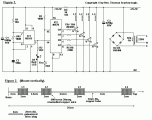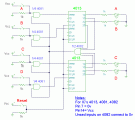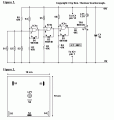Fun and games schematics
 The circuit turns on a light corresponding to the first of several buttons pressed in a "Who's First" game. Three stages are shown but the circuit can be extended to include any number of buttons and lamps....
[read more]
The circuit turns on a light corresponding to the first of several buttons pressed in a "Who's First" game. Three stages are shown but the circuit can be extended to include any number of buttons and lamps....
[read more]
 The particular circuit is substantially a generator of accidental numbers, from 1 until the 6. The clue him we see in a line from led, that each one corresponds also in a number from the 1-6, if push and leave, the S1 (push button). This movement corresponds in a movement of dice. The led that it turned on will remain turned on for five until ten seconds and afterwards it will black out, waiting for the next movement....
[read more]
The particular circuit is substantially a generator of accidental numbers, from 1 until the 6. The clue him we see in a line from led, that each one corresponds also in a number from the 1-6, if push and leave, the S1 (push button). This movement corresponds in a movement of dice. The led that it turned on will remain turned on for five until ten seconds and afterwards it will black out, waiting for the next movement....
[read more]
 This circuit is a small digital roulette''. It is constituted by oscillator IC1, the counter IC2, the transistors Q1-7 that drive the display common cathode DSP1. The supply basically becomes from a battery 9V, but can become also from one power supply....
[read more]
This circuit is a small digital roulette''. It is constituted by oscillator IC1, the counter IC2, the transistors Q1-7 that drive the display common cathode DSP1. The supply basically becomes from a battery 9V, but can become also from one power supply....
[read more]
 Electronic Dice with LEDs...
[read more]
Electronic Dice with LEDs...
[read more]
 This electronic game pits a human player against the ‘machine’. The opponents use a common ‘game token’ and take turns moving along a path by one, two or three steps, and the winner is the first one to reach the goal exactly. Incredibly enough, this simple version of the ‘123’ game can be built without a microcontroller, and it’s almost impossible to beat....
[read more]
This electronic game pits a human player against the ‘machine’. The opponents use a common ‘game token’ and take turns moving along a path by one, two or three steps, and the winner is the first one to reach the goal exactly. Incredibly enough, this simple version of the ‘123’ game can be built without a microcontroller, and it’s almost impossible to beat....
[read more]
 When optimally tuned, it will propel a small slug about 1.5 metres high, or 2.5 metres horizontally....
[read more]
When optimally tuned, it will propel a small slug about 1.5 metres high, or 2.5 metres horizontally....
[read more]
 Quiz Circuit...
[read more]
Quiz Circuit...
[read more]
 The simple conjuring trick is intended to provide some enjoyment for the beginner in electronics or conjuring, and should take only an hour or two to build....
[read more]
The simple conjuring trick is intended to provide some enjoyment for the beginner in electronics or conjuring, and should take only an hour or two to build....
[read more]